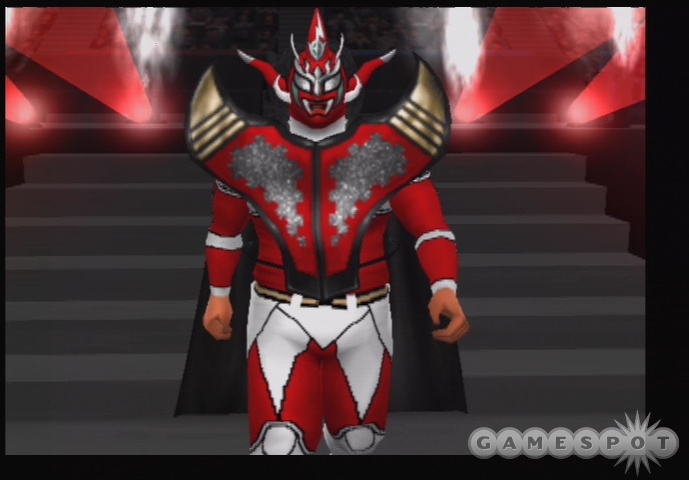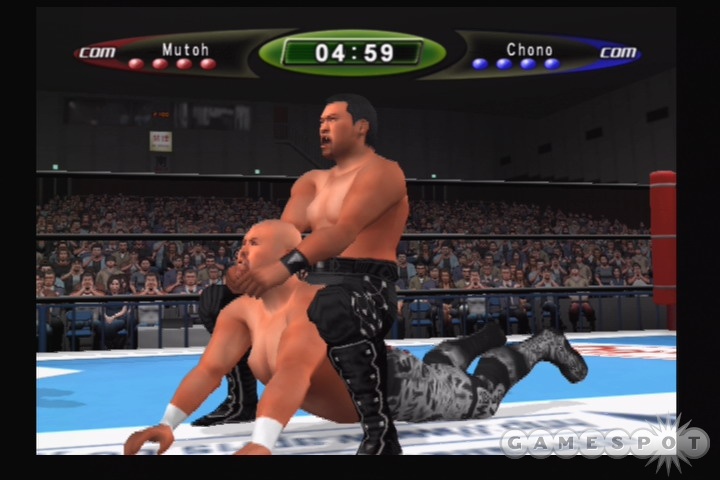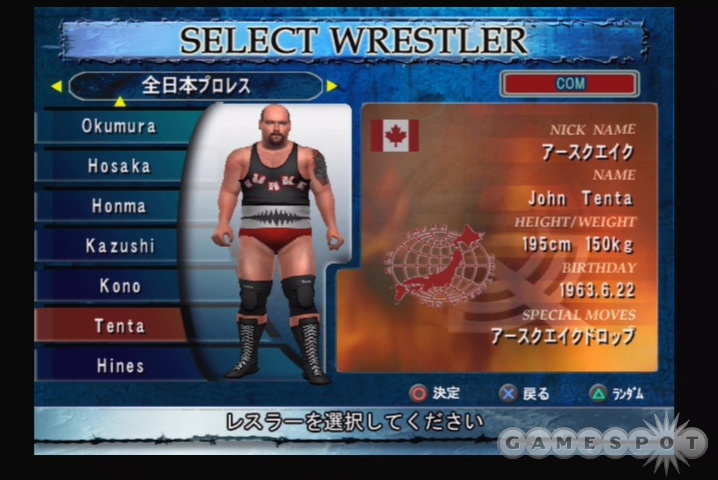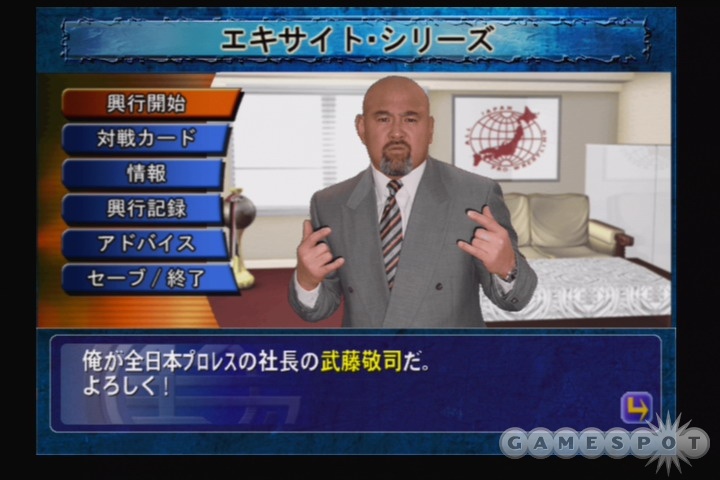IMPORT REVIEW--It was a sad time for wrestling fans everywhere in 2003 when Spike released Fire ProWrestling Z for the PlayStation 2. Not because the game was bad, mind you, but because it was the last in the company's devoutly followed 2D wrestling franchise that spanned multiple decades and console generations. Six months before Fire Pro Z's release, Spike put out King of Colosseum for the PS2, a game that purported to be a 3D realization of the Fire Pro style of gaming. Although King of Colosseum was met with somewhat lukewarm reactions, Spike made it clear that it was going in a 3D direction. Fans could only hope that the eventual sequel would deliver a deeper experience. Boy has it ever. King of Colosseum II for the PlayStation 2 is a near-revelatory experience at times, effectively capturing the same great methodology of wrestling gameplay that the Fire Pro series utilized so well, yet still managing to keep enough 3D wrestling conventions mixed in to balance the overall experience. This is by no means the perfect wrestling game, as the presentational components could certainly have used some additional work, but all told, this is easily among one of the best wrestlers to come out of this console generation.

King of Colosseum II doesn't really feature very many wrestlers you're likely to have ever heard of, unless you follow Japanese pro-wrestling, or "puroresu." Unlike the Fire Pro games, Spike has actually licensed a host of real Japanese pros from several major promotions, including New Japan, All Japan, Pro Wrestling NOAH, Zero-One, and World Japan. The Fire Pro games featured rosters of entirely fake wrestlers, which happened to be just slightly different than real-life wrestlers (so as to avoid any infringement within the Japanese copyright laws). However, there are nearly 150 real wrestlers available in this game, almost all of which are available from the get-go. On top of all of these, there are 125 unlicensed wrestlers and mixed martial art fighters to unlock, which are just marginally different from real-life competitors, ranging from the likes of Giant Baba to Mike Tyson.
Again, even with this insane number of competitors to choose from, unless you ardently follow Japanese wrestling, you won't see a lot of familiar faces. Most of the American wrestlers in the game are made up of former mid-carders who have made it big in Japan (Scott Norton, John "Earthquake" Tenta, Mike Awesome, and so on), but there are also a few unlockable popular American wrestlers, like Hulk Hogan, Chris Benoit, Brock Lesnar, Rick and Scott Steiner, and Andre the Giant. Even if you aren't a big puroresu fan, there are still some notable American wrestling names (or, at least, faces, since the characters have been slightly altered to get around having to actually license these guys) to play around with.
Honestly though, there's no reason why the lack of familiar grapplers should hinder you one bit. For starters, the gameplay is so good that the roster should be practically incidental. The face buttons on the controller represent specific attacks on their own, each of varying degrees of strength. However, if you press each one of these buttons when you lock up into a grapple, it will set up a specific type of grapple attack. The grappling engine actually works differently from the Fire Pro series, in which you'd simply walk up to a wrestler and automatically lock up with him. Here, by pressing the R1 button in conjunction with any of the face buttons, you'll attempt a grapple. Depending on the face button pressed, you'll go into a different animation, which also depends on what types of attacks a wrestler has assigned. So, for instance, pressing the square button with the grapple modifier could either set up a suplex or a strike of varying strength, depending on the wrestler's move setup.
Once you're in a grapple, you'll then have to time a second button press to actually execute your attack. This is where the similarity to the Fire Pro games pops up again, as the timing required to make the attack happen is fairly precise. You'll also need to take into account where you are in a match. If it's early, going for a big move isn't likely to work and it will most likely be reversed. The reversal works on a similarly timing-based system, but it also plays into how much stamina your wrestler has. If you're still in good shape, then you're far more likely to reverse an attack. Conversely, if you've been worn down, it'll be much tougher to reverse your opponent's maneuver. The cool thing is that the game uses Fire Pro's fatigue system, or at least a close approximation of it, so as you go through a match you'll actually see your wrestler start to get winded. This feature ties into how much energy you put forth in a match too, so you'll want to be strategic with your attacks, as throwing a lot of missed strikes and grapples will cause you to get tired more quickly. You can recover stamina by standing still and holding down the L1 button, but it's better to just not waste energy to begin with.
All of the above is enough to make for a deep and enjoyable wrestling game, but there is still more to the gameplay system. The opponent artificial intelligence really stands out, as it works absolutely brilliantly. There are several different difficulty levels in the game. Anything level five and above should start you off with a solid challenge, and the higher you go, the more brutal they become. Even better than the challenge is the level of realism you'll see in the behaviors of your opponents. The logic for each wrestler, just like in the Fire Pro games, has been finely tuned to mimic the real-life strategies and methodologies for each wrestler, and it shows. High flyers will go for their big spots, submissions wrestlers will typically try to keep you on the mat and make you tap out, and the big men will lumber around the ring, trying to power their way through you. The pacing of the action is so beautifully balanced and really emulates puroresu-style wrestling with amazing accuracy. And while that might not be as flashy as American wrestling games typically are, it's a hell of a lot more competitive and also a lot more fun than most of them tend to be.

On the play mode side of things, King of Colosseum II is pretty well stacked. The actual number of available match types isn't huge, but for an exhibition bout, you can still choose from single, single (with manager), tag team, handicap, triple threat, four-man battle royal, and five-versus-five elimination bouts. You can choose varying rule sets, including everything from American-style matches to mixed martial art bouts, and you can even pick what ring announcer or referee you want working the match. There is also a series mode, which lets you hold various league-style tournaments, as well as a title match mode that lets you compete for or defend any of the 20 different championship belts featured in the game. There are also a few nonstandard play modes in the game, including the survival road and matchmaker modes.
Survival Road is where you'll spend the bulk of your early time with the game, as it is where you can unlock all the hidden goods King of Colosseum II has to offer. The mode itself is much simpler than its Fire Pro equivalents, simply letting you choose one of the five different leagues available, a wrestler, a partner, and then sending you on your way. You'll actually only end up wrestling seven matches during the course of one league's survival road, but you'll have to make each match count. Much of what you can end up unlocking is based upon winning and how well you perform in a match. What this means is that you not only have to worry about winning, but also how good of a performance you put on. You see, if you don't please the fans, then you'll be graded poorly. The fans are finicky too; they hate one-sided drubbings and don't like things like repeated moves or quick finishes. They want long, competitive bouts. So you may actually find yourself purposely getting beaten up from time to time just to try to balance things out. It's a little unwieldy at first, but after a while you'll probably find yourself actually working hard to try to make the best match possible.

Once you've beaten a league, you'll unlock some hidden material into the game's "secret shop." Here is where you unlock everything from wrestlers to hidden rings and bonus attribute points for the create-a-wrestler mode. The one sort of tricky thing about the secret shop is that many of the wrestlers you unlock won't just become available in the game. These wrestlers are actually templates that you'll use in the create-a-wrestler mode to make the actual wrestler. This is a tad annoying, as it means you'll have to use CAW slots on your memory card for each wrestler you end up creating. However, you can save 100 wrestlers per memory card. So, if you've got a couple of cards handy, it should be no big deal at all.
The matchmaker mode is actually the closest thing to a wrestling management sim you'll find on a console. Again, you'll pick from one of the five leagues. You'll find yourself in an office with one of the heads from each league standing before you, ready to school you on what you need to do to book a successful show. You're given a roster of talent to use and set goals for attendance and an average match-quality grade. However, while all of these things are pretty easy to figure out, the game also requires some specific objectives for each card that won't be readily apparent to you unless you can read the Japanese text menus. Also, even if you rename all your wrestlers to their English translations, this mode inexplicably won't use them, so you'll have to figure out their Japanese names and memorize them in order to book effectively. It's unfortunate that this is the case, as the mode is actually pretty cool once you figure it all out. But, then, those are the breaks when you import foreign games.
Last, but most certainly not least, there is the wrestler-edit mode, also known as the create-a-wrestler mode. Here, you can edit any aspect of a wrestler already in the game, use templates to create new wrestlers, or just create your own guy. The number of options here is Fire Pro-like in scale, with insane numbers of appearance options, moves, skills, attributes, and AI options to program. It can literally take you an hour or more to make an original creation, and it's not because of the Japanese-heavy menus; it's because there are so many options to play around with. This may seem highly insurmountable at first, but there are a few different translation FAQs out there that detail nearly every aspect of this mode, and after a while, creating wrestlers becomes a breeze. The only negatives about the edit mode are mostly small quibbles. For instance, the game still relies on the old Fire Pro facial-editing system in which you can only choose from single, preset heads. You can't edit any specific facial details, or any masks, beyond color schemes. Considering that every major CAW mode in wrestling gaming today lets you edit faces, and even the SmackDown! games have a basic mask editor (despite the fact that the WWE has almost no masked wrestlers to speak of these days), this is fairly disappointing. Then again, there are hundreds of heads to choose from, so you're likely to find at least a few of them to your liking.
While the gameplay and features in King of Colosseum II are wholly impressive, its presentational components unfortunately are not. Graphically, the game just doesn't quite measure up to what other wrestling games have managed to accomplish with the PS2 hardware. Sure, the wrestler models are quite good and the cutscene animations for many of the specialized maneuvers look similarly good, but a lot of the basic match action isn't very appealing. Wrestlers move very stiffly, almost like they have a steel pole taped to their back that is trying to keep them in perfect posture. Also, some transitions between moves and certain counters just don't end up looking right. Either some big clipping problems will show up or the animations will just glitch out. This is especially unfortunate, because it's really the only thing that kind of takes you out of a match. The overall match flow is so realistic that it's really jarring when you see a guy jump from a dropkick animation to lying flat on the ground in a split second with no transition in between.

The game's sound is the most noticeable weakness in King of Colosseum II. This game just does not sound good at all; it actually sounds a lot like a Fire Pro game. The music is about a step above MIDI quality, and the voice samples used for the wrestlers are just about as poorly compressed as you can get. To be fair, there are about a billion (or at least it seems like that many) different voice samples and musical tracks in the game, so it's not totally incomprehensible why the audio quality would be pared down. The one, lone bright spot of all the audio is the in-game commentary. Though you won't have a clue what the commentators are saying if you don't know Japanese, you'll still enjoy it, because the commentators are extremely energetic and will yell out some great exclamations in response to certain animations.
Perhaps the most unfortunate thing of all about King of Colosseum II is that it hasn't a snowball's chance in hell of ever coming out in North America. This is strictly an import title--a fairly pricey one at that--going for around $80 on nearly every import site we researched. Then again, for a game that plays as well and features as much content as King of Colosseum II does, it's hard to really complain too much about the price. To put it in no uncertain terms, this is easily one of the best wrestling games to come out of Japan since AKI's Virtual Pro Wrestling 2, and it finally delivers on Spike's promise of a 3D successor to the Fire Pro franchise. If you have the means to import and play Japanese games, and you're a fan of wrestling, King of Colosseum II belongs in your collection.